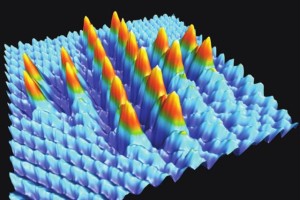
20 bromine atoms were positioned on a sodium chloride surface using the tip of an atomic force microscope at room temperature.
In the early days of this blog, Annie Goedkoop, Director of Publications for ECS, has been a great source for posts. Her latest from Engineering and Technology Magazine is about a discovery ECS member and past meeting attendee, Ernst Meyer, and his team are working on:
The first successful systematic atomic manipulation on an insulating surface at room temperatures has been achieved and presented by international researchers at the University of Basel, thereby taking the manipulation of atoms to a new level.
It is significant because it opens up the possibility for the creation of next generation atomic-scale data storage devices and logic circuits, and the fabrication of a new generation of electromechanical systems.
The scientists used the tip of an atomic force microscope and placed single bromine atoms on a sodium chloride (NaCl) surface to construct the shape of the Swiss cross. The tiny cross is made of 20 bromine atoms and was created by exchanging chlorine with bromine atoms. It measures only 5.6nm square and represents the largest number of atomic manipulations ever achieved at room temperature.
“Essentially, you can think about it as an ultra-dense storage medium, where information can be stored with a few atoms,” Head of Research, Ernst Meyer, explained.
“Alternatively, one may think to create logic circuits as in a processor. NaCl is an insulator. If we can write conducting lines, one may build a network.”
And yes, ECS has a division for that.
More on atomic level manipulation in the ECS Digital Library.
Contributions and guest writers are welcome BTW. Just contact me: rob.gerth@electrochem.org.

